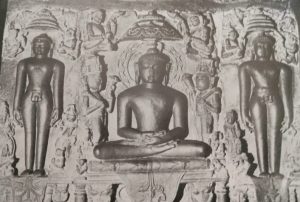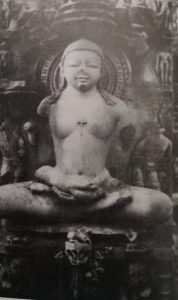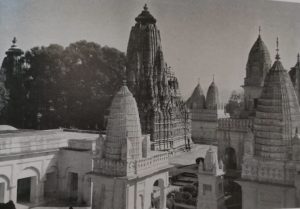Khajuraho
 A be image of the third Jina (see previous page).
A be image of the third Jina (see previous page).
Khajuraho needs no introduction as to its location, history and architecture. Many al western visitor will go away from this rightly famous place with the incorrect view that Jainism is merely a slightly different branch of Hinduism.
Is the architecture and art of the Adinatha and Parshvanatha temple, he might ponder, not sufficient proof of resemblance between the two religions? It needs a more thorough look than hurried tourists can spare to take and, preferably, an informed guide to see and comprehend their difference (see appendix under Khajuraho).
 Khajuraho Jaina Museum. Seated Adinatha. Marble. For close- up see page 6.
Khajuraho Jaina Museum. Seated Adinatha. Marble. For close- up see page 6.
(abovs Khajuraho, part view of Jaina temple compound. The Parshvanatha Temple in the centre, built in the tenth century, only a few decades after the Adinatha Mandir (partly hidden behind trees). dominates the skyline. The other buildings are of later centuries.
The Shantinatha Mandir (not in the photo). which enshrines a standing Jina of 4.5 metres height has been drastically re- novated. Loose sculptures from the ruined Ghantai and other no longer extant tem- ples are exhibited in the Jaina Museum placed out- side the compound gate.
Parshvanatha Temple, detail of southern façade. Sandstone.